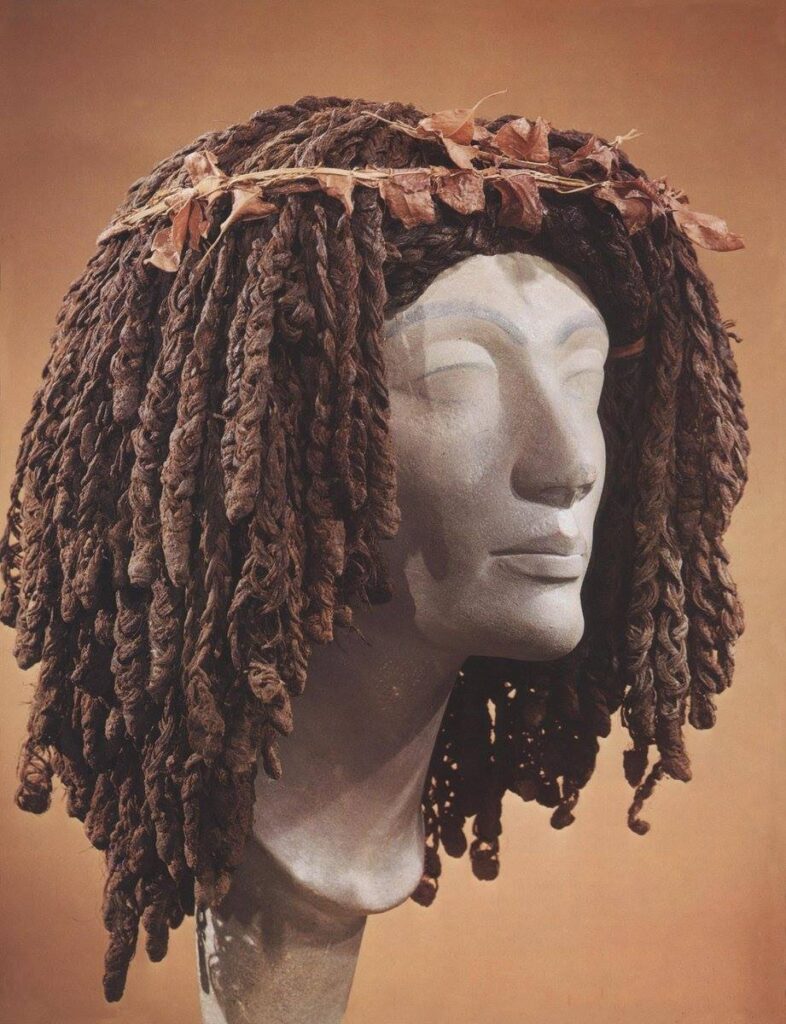Introduction
Nauny, an Ancient Egyptian princess from the Twenty-first Dynasty during the Third Intermediate Period (c. 1070–945 B.C.), offers a fascinating lens through which we can explore Ancient Egyptian culture, particularly its funerary practices and emphasis on appearance. Her wig, discovered during excavations in the late 1920s, stands as a remarkable testament to the artistry and beliefs of her time.
Who Was Nauny?
Nauny was likely the daughter of Pinedjem I, the High Priest of Amun who later declared himself pharaoh in 1054 B.C., and Tentnabekhenu, as identified from Nauny’s funerary papyrus. She bore titles that emphasized both her royal heritage and her religious significance:
- “King’s Daughter of His Body” underscored her status as a direct royal descendant.
- “Singer of Amun” connected her to the worship of Amun, a major deity in Egyptian religion.
- “Lady of the House” reflected her role within domestic and ceremonial contexts.
These titles highlight Nauny’s prominence within both the royal and religious hierarchies of her time.
The Discovery of the Wig
Nauny’s burial was uncovered at Deir el-Bahari in Tomb TT 358, also known as the Tomb of Meritamun, during the 1928–29 Metropolitan Museum of Art excavations. The wig was found lying behind her mummy’s head in the inner coffin, a deliberate placement that suggests its importance as part of her funerary preparation.

Craftsmanship and Materials
The wig is a masterpiece of Ancient Egyptian hairdressing:
- It was crafted from human hair, intricately plaited into elegant braids.
- The plaits were secured at the top with a cord, ensuring durability.
- The hair was treated with beeswax and coated with animal fat, a common technique to preserve and style hair, while also giving it a shiny, well-maintained appearance.
This combination of materials and techniques not only preserved the wig’s structure for thousands of years but also demonstrated the Egyptians’ advanced understanding of hair care and preservation.
Cultural and Religious Significance
The Role of Wigs in Ancient Egypt
Wigs in Ancient Egypt were more than practical accessories; they were symbols of status, hygiene, and spirituality. Both men and women wore wigs during ceremonial occasions and daily life, often enhancing their appearance with elaborate hairstyles. Wigs were also an important part of funerary customs, as they reflected the belief that personal adornment was necessary for eternal life in the afterlife.
Funerary Practices
The inclusion of the wig in Nauny’s burial reflects the Ancient Egyptian belief in presenting oneself at their best in the afterlife. Personal appearance was considered a vital aspect of one’s identity, and items like wigs, jewelry, and cosmetics were often included in tombs to ensure the deceased could maintain their appearance for eternity.
Preservation and Legacy
A Testament to Egyptian Expertise
The exceptional preservation of Nauny’s wig showcases the skill of Ancient Egyptian hairstylists and their expertise in combining aesthetics with durability. Even after more than 3,000 years, the wig’s plaits remain intact, offering insight into the care and attention given to funerary artifacts.
Insights into Daily Life and Beliefs
The craftsmanship of the wig sheds light on daily life, highlighting the importance of personal grooming and societal values in Ancient Egypt. Moreover, its presence in Nauny’s tomb reaffirms the Egyptians’ deep-seated belief in the afterlife and their meticulous preparation for eternity.
Conclusion
Nauny’s wig is more than a well-preserved artifact—it is a window into the world of Ancient Egypt. It reveals not only the artistry and technical skill of its makers but also the cultural and spiritual values of the society that created it. Through this singular object, we gain a deeper understanding of the Egyptians’ reverence for appearance, their advanced techniques in preservation, and their unwavering belief in life beyond death.
By studying artifacts like Nauny’s wig, we continue to unravel the rich tapestry of Ancient Egyptian civilization, a culture that remains a source of fascination and inspiration even today.

